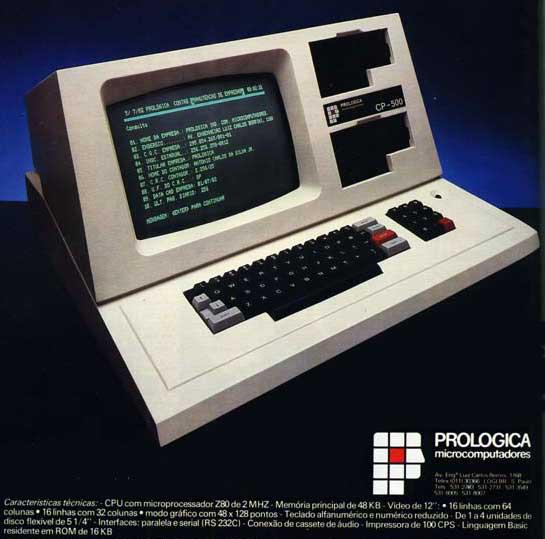CP-500 (TRS-80)


CP-500 (TRS-80)
Reactivating an old post I made with new information, about this one that was a technology icon in the 80’s in Brazil, the famous CP-500, considered by many to be the first personal computer in Brazil.
The “CP-500” was a computer manufactured by Prologica during the 80’s in Brazil. Based on the American “TRS-80” architecture, it used the “Z80” processor and its system was the Basic, so there was software compatibility between the American models.
Period advertisement (left).
The “Prológica“
Leonardo Bellonzi and Joseph Blumenfeld in March 1976 decided to market the prototype of the accounting machine they had just assembled. Six months later, they launched the machine on the market, going from distributors to producers of electronic equipment.
Thus was born the company that, from 1980 onwards, would occupy an outstanding position among the national producers in the area of information technology – Prológica Indústria e Comércio de Microcomputadores Ltda. In 1985, Prológica was in third place in the ranking of national companies in the sector, employing more than 1,500 employees. The line of PCs ranged from simpler models like the CP 200 and CP 300 to medium equipment like the CP 500.

In the professional equipment sector, Prológica produced the Sistema 600, Sistema 700 and Super 700, all 8-bit, and in 1985, following the trend of the international market, it launched the SP 16, a 16-bit micro modular compatible with IBM PRAÇA.
Dot matrix printers, winchester hard disk drives and floppy disk drives completed its product line.
More details
The “CP-500” was one of the best-selling national microcomputers in its market range. It was the first national micro fully compatible with the TRS-80 Model III, manufactured by the American Tandy Radio Shack. Robust and versatile, the original CP 500 (in beige) was a medium-sized computer, being widely used for various purposes, due to the various peripherals and the large amount of software available for the most varied applications.
The CP 500 has all its basic components integrated in a single enclosure made of polyurethane, meaning the CPU, keyboard, video and one or two floppy disk drives are all part of a single console, with no external wires to connect. It is based on the 8-bit Zilog Z 80A microprocessor, operated with a 2 MHz clock. The CPU, main memory and basic I/O controllers are mounted on a single motherboard, with separate power supply, but inside the same cabinet, ventilation is also internal.
All input, output and control signals from the bus are available on an edge connector at the rear of the cabinet. Through it, expansions or peripherals could be connected. On the back there are also connectors for parallel output (printer), serial (RS-232C), for two additional external floppy drives, and for a cassette recorder. In its 16 Kbytes of ROM memory the monitor and system are pre-recorded. the BASIC level II interpreter, in the basic version had 16 Kbytes of RAM, which could be expanded to 48 Kbytes. It also had a second RAM memory of just 1 Kbyte, used as a video buffer. Internally, the CPU has a loudspeaker and a real-time clock, with date and time, accessible through software.
Prológica itself offered a wide variety of peripherals for the CP 500, including dot matrix printers. The cheapest was the P 500, specially designed for the CP 300 and CP 500, bidirectional, with a speed of 100 characters per second and 80 columns in normal print mode. For heavier use, I had the P 720 printer at 200 cps and P 725 at 250 cps, both 132 positions wide. Other peripherals were: stereo sound, joystick, plotter, RS-232C type biserial communication board (110 to 9,600 bps, in synchronous and asynchronous mode) and modem. The CP 500 in its basic version had only the BASIC level II monitor and interpreter system, residing in ROM.
In the system with floppy disks, the user had the extended BASIC, much more powerful, which included commands to access floppy drives. The DOS 500 operating system was fully compatible with the standard DOS of the TRS-80 Model III. Due to its full compatibility with the TRS-80 family models, the CP 500 could use a huge variety of application software, covering the most diverse areas such as: educational, financial, recreation, administrative, etc.
CP 500/M80C
Prológica launched in 1985 the CP 500/M80, an improved model of the CP 500, it was a microcomputer with the same external appearance as the original CP 500, but in graphite color, it operated with two operating systems, the traditional DOS 500 and the SO- 08 (compatible with CP/M). Using the CP 500/M80 with the SO-08, the user had 64 Kbytes of RAM memory and 2 Kbytes of ROM memory, the monitor worked with 24 lines and 80 columns.

It also had a larger library of programs, as the SO-08 was CP/M compatible, it could run programs like CalcStar, Dbase II, WordStar and Prológica application programs compatible with System 700 and many others. With the installation of an RS-232C port, it was possible to access Videotexto, Cirandão (Ciranda Project), Aruanda etc.
In 1986, Prológica launched the CP 500/M80C (“C” for compact). It was 30% more compact, due to the new 5.25 inch drive model used, while previous models used the full height drive (high), the new drive was slim (half the height). The position of the drives also changed, becoming vertical. The color of the M80C was white, the rest of its features were the same as the CP 500/M80. A year later, Prológica launched the CP 500 Turbo, the main innovation being the 4 MHz clock.
Keyboard
The keyboard is integrated into the front of the case, it is professional type, with 65 keys and QWERTY layout in the basic block. It could enter upper and lower case characters, plus cursor control, screen, correction, and input functions. All keys have auto-repeat function. There is also a separate numeric pad, suitable for quick typing of numbers. On the right side of the numeric keypad, the CP 500 RESET button is located in a cavity.
Video
The video monitor, also integrated into the case, is 12 inches, with a green phosphor screen. The screen format is 16 lines of 64 characters, the expanded mode can be selected by software with 32 characters of double width. In the standard graphics mode, the resolution is 128 x 48 pixels, with individual addressing by software, or 64 semi-graphic characters and 160 special characters. Optionally could add a high resolution graphics control card (502 x 192 pixels, inverse video and three shades of gray).
Memory
The basic version of the original CP 500 used as auxiliary memory only a common cassette recorder (this configuration was rarely used), connected through the EAR (headphones), AUX (microphone) and REMOTE (motor control) connectors. The baud rate could be software programmable at two levels: low speed (500 baud, approximately 63 characters per second) or high speed (1,500 baud, approximately 190 cps). In the expanded version, one or two 5.25-inch (full height) floppy disk drives, single-sided and double density, could be placed in the case in a horizontal position. Floppy disks were formatted by software, in the TRSDOS standard, with 40 tracks of 18 sectors of 256 bytes, and total capacity of 178 Kbytes each. Two other floppy drives could be added externally.
NOTE: Some information was taken from the website www.mdutra.com




Paramètres